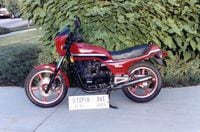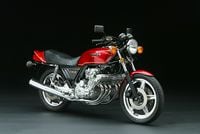Yesterday, as I made yet another trip to Century Motorcycles in nearby San Pedro, California, to pick up my much-flawed 1983 GPz550 (you’ll be reading about this lovely-yet-cursed machine a lot here in the coming months), I started thinking about all the bikes I’ve owned since my very first motorcycle—a 1971 Honda SL70 Motosport my parents rolled into our garage on the 24th of December that same winter. (Hidden under a blanket, it remained undiscovered until the next morning—a morning that changed my 10-year-old life in dramatic fashion. Those of you who got motorcycles early in life know exactly what I mean.)
So I began making a list. And when it was finally complete a day or so later (hey, I’m 53, and a little memory-challenged), I had to laugh. Not at the bikes themselves, as all are worthy classics in my mind, but at how many there were—more than 40—and how fickle I’d been over the years, buying and selling so many.
Of course, there are some very good reasons for that… my fickleness, and my lack of “collector” status: limited money, of course, and garage space. Most of you probably know these afflictions all too well. I mean, would I enjoy having all of the bikes on my list in a very large garage, one stocked with lifts, tools, a refrigerator with a tap, and plenty of music-making electronics? You betcha. A few of my friends are fortunate in this respect, and I envy the hell out of them—and live vicariously through them. But alas, it just isn’t in the cards for this writer/rider.
Over the years I basically bought what I liked and could afford. And since the money tree I planted years ago still hasn't produced fruit (I keep waiting….), I sold bikes I could live without to finance bikes I couldn't. Which means I could only have a few of my faves at any one time. I guess I just want to sample every bike I found interesting. And every once in a while, when I realized I had a few too many (as I did a couple of years ago), the remedies came in the form of Craigslist and eBay, all helped along by my wife's evil eye.
After that life-changing SL70 came a series of dirtbikes, and a career as an amateur motocrosser. There was the first-gen XR75 that arrived in late ’73, my first-ever race on it in that following summer, a big-bore kit and exhaust over the winter, and, after getting tossed off at Mid Ohio Moto Park, a monoshock suspension in back. That thing was really cool.
In ’76 came a Yamaha YZ100C monoshocker, which also got heavily modified—a porcupine head, “Afterburner” pipe and Lectron carburetor leading the list. It was fast as hell, and I won races on it (even getting top-five finishes in the 125 class), but it blew up about every third weekend. The following two years brought two more Yamahas: a ’77 YZ125D and a ’78 YZ250E, both of which remained basically stock and therefore extremely reliable. Wonderful years, those.
My first streetbike came in college two years later, a dark-blue and well-used Yamaha XS650 twin I used for transportation to and from campus. I wore my red and yellow Electro motocross helmet and Scott goggles when riding it, which had to be quite a sight—unless you couldn’t pull your eyes from the garish sissy bar bolted to the back of the thing, which for some strange reason took me a long time to remove. Embarrassing.
A couple of years later I got my first sportbike, a two-year-old Suzuki GS1000S I bought from my college buddy Nick Ienatsch. I fell in love with sport motorcycles with that one, and was beginning to figure out asphalt-based vehicle dynamics when an ugly crash in Little Cottonwood Canyon totaled the thing—and almost killed me. It’s amazing how heavy a bike suddenly becomes when you jam on the brakes mid-corner and shoot directly toward a pile of Datsun-sized rocks.
A 1982 GPz550 monoshocker replaced it in ’83, as did an ’83 KX250 motocrosser. With the KX I took up motocross racing again after a five-year hiatus, and to say the sport had changed between ’78 and ’83 would be an understatement. I loved that GPz, but wasn’t able to appreciate its superb handling due to its nearly bald tires— and the fact that I wasn’t able to afford new ones. Dumb.
After getting a job at a local Honda dealer in '83, and after busting my collarbone and wrist in a motocross accident at the beginning of '84 on a CR480 I'd bought, I purchased a brand-new Honda 500 Interceptor—and the sportbike lust that had sprouted a couple of years earlier really began to blossom. Here was a streetbike that really handled, never mind that the thing was pitifully slow at Salt Lake's 4,500-foot altitude—and higher still in the area's mountains and canyons. Still, it taught me to ride well, and I ended up doing my first roadrace on it at the legendary Speedrome in Las Vegas, now the site of Las Vegas Motor Speedway. It had a Dunlop 291 Sport Elite up front and a Pirelli Phantom (remember those?) in back, and I remember how my Utah buddies freaked out after seeing how scorched and melted the tires were right to the very edges of the tread when I got back from Vegas. Good times.
I bought a yellow and black RZ350 in mid '85, only to find out a few weeks later I was moving to Southern Cal to join the staff of Motorcyclist. Knowing I wouldn't need a streetbike of my own once there, and needing money quite badly, I sold the Interceptor and RZ, and headed south to begin a job I could only have dreamed of six months before. That SL70, and my wonderful parents, certainly pushed me in a good direction.
After four years at Motorcyclist, American Honda offered me nearly double what I was making as an editor to do product-planning and testing. Wanting a change, and wanting to make more money, I jumped at the chance to be involved in real R&D. While there, I bought and sold a number of CBXs, two '79s and a couple of the '81-'82 bagger models. I ended up selling all of them, thinking I'd make some money, which never panned out, of course. I should have kept both '79s, one of which I sold to a Honda exec and ended up being photographed for the CBX Roots piece we published a couple of months ago.
I also bought a super-clean and bright-yellow 1975-spec CB400F while at Honda, which I loved to look at. Problem was, I didn’t like to ride it all that much, as it was amazingly underpowered and way too small for me.
When I left Honda to be Cycle World's Managing Editor in 1992, I stumbled onto a pair of first-generation (so-called K0) CB750 Hondas for sale in central Illinois in Walneck's Cycle Trader. They were rough but they ran, and I came up with a story idea that editor David Edwards approved immediately: We'd fly to Illinois, buy the bikes, and ride them back to Los Angeles on Route 66, chronicling the story and shooting pictures the entire way. The trip took us 11 days, and we had plenty of problems along the way, including spending a few days in Tulsa rebuilding the top end of my K0 with pistons sourced from a junkyard. But in the end it was an amazing trip, and it made a great story in the magazine's pages.
Like a dummy I sold my 750 Four, as it was very rough, and I simply didn’t have the money or time to restore it. Edwards did it right, eventually having his restored and enjoying it for many years. Another lesson learned, though I knew I’d have another K0 at some point.
The chance came in the late 1990s, a few years after I'd gone back to Motorcyclist as Editor in Chief in 1993. My buddy Vic World, who does the world's best CB750 Sandcast restorations, offered to sell me his 5600-mile, 1970-spec CB750, which was nearly perfect, and completely original. I snapped it up, knowing I'd enjoy riding (a little) and salivating over it (a lot). I did a redux of that CB750/Route 66 story a few years later, and riding it along The Mother Road was an amazing experience after all those years.
Mitch Boehm, 53, began riding at age nine, and racing at age 11. His moto career includes staff stints at Motorcyclist (18 years), Cycle World and American Honda, plus he recently helped Malcolm Smith write his autobiography. All of which qualifies him to jabber away endlessly about old stuff.











/cloudfront-us-east-1.images.arcpublishing.com/octane/UUVQL5T33ZUAFDTJS5OXAOLHVE.jpg)














/cloudfront-us-east-1.images.arcpublishing.com/octane/3TIWWRV4JBBOLDVGRYECVVTA7Y.jpg)
/cloudfront-us-east-1.images.arcpublishing.com/octane/KIX5O23D5NAIBGFXBN3327DKZU.jpg)
/cloudfront-us-east-1.images.arcpublishing.com/octane/7GJYDUIPXRGMTMQKN6ONYOLBOU.jpg)
/cloudfront-us-east-1.images.arcpublishing.com/octane/MUQLOVLL2ZDGFH25ILABNBXKTI.jpg)
/cloudfront-us-east-1.images.arcpublishing.com/octane/TNOU5DNE2BC57MFPMGN2EIDXAM.jpg)
/cloudfront-us-east-1.images.arcpublishing.com/octane/GTCXACQGJ5HAPDTGWUQKDEH44E.jpg)
/cloudfront-us-east-1.images.arcpublishing.com/octane/S35YGSEMEZB4BLTDJTSZPF4GLA.jpg)
/cloudfront-us-east-1.images.arcpublishing.com/octane/5UOT6HPX2JFMRJAX6EH45AR4MQ.jpg)
/cloudfront-us-east-1.images.arcpublishing.com/octane/OKWOJWAKP5EP3OACCRRWPCIX2Q.jpg)
/cloudfront-us-east-1.images.arcpublishing.com/octane/2WF3SCE3NFBQXLDNJM7KMXA45E.jpg)
/cloudfront-us-east-1.images.arcpublishing.com/octane/G4MG6OUCJNBSHIS2MVVOTPX65E.jpg)
/cloudfront-us-east-1.images.arcpublishing.com/octane/IIGGWFOTOJGB7DB6DGBXCCMTDY.jpg)
/cloudfront-us-east-1.images.arcpublishing.com/octane/QSTCM6AVEZA5JJBUXNIQ3DSOF4.jpg)
/cloudfront-us-east-1.images.arcpublishing.com/octane/U4I7G625B5DMLF2DVIJDFZVV6M.jpg)
/cloudfront-us-east-1.images.arcpublishing.com/octane/B6XD6LS6IVCQPIU6HXDJSM3FHY.jpg)
/cloudfront-us-east-1.images.arcpublishing.com/octane/ICL63FEDDRDTTMINYICCEYGMDA.jpg)
/cloudfront-us-east-1.images.arcpublishing.com/octane/FCGZHQXRBZFLBAPC5SDIQLVF4I.jpg)
/cloudfront-us-east-1.images.arcpublishing.com/octane/WNOB6LDOIFFHJKPSVIWDYUGOPM.jpg)

/cloudfront-us-east-1.images.arcpublishing.com/octane/X33NU3E525ECRHXLNUJN2FTRKI.jpg)
/cloudfront-us-east-1.images.arcpublishing.com/octane/6KKT5NNL2JAVBOXMZYS5ZO76YA.jpg)
/cloudfront-us-east-1.images.arcpublishing.com/octane/J5RKG5O455GMPGQRF2OG6LRT7A.jpg)
/cloudfront-us-east-1.images.arcpublishing.com/octane/GX2CIZKQVRH2TATDM26KFG2DAE.jpg)